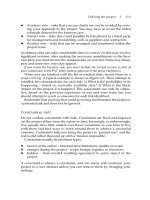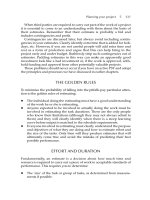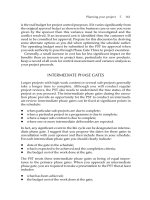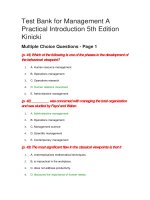Management a practical introduction 3rd kinicky chapter 07
Bạn đang xem bản rút gọn của tài liệu. Xem và tải ngay bản đầy đủ của tài liệu tại đây (275.96 KB, 47 trang )
Management
A Practical Introduction
Third Edition
Angelo Kinicki &
Brian K. Williams
Kinicki/Williams, Management: A Practical Introduction 3e ©2008, McGraw-Hill/Irwin
Chapter 7: Individual & Group
Decision Making
How Managers Make Things
Happen
The Nature of Decision Making
Rational & Nonrational Decision Making
Evidence-Based Decision Making & Analytics
Making Ethical Decisions
How to Work With Others
How to Overcome Barriers to Decision Making
Kinicki/Williams, Management: A Practical Introduction 3e ©2008, McGraw-Hill/Irwin
7.1 The Nature Of Decision Making
HOW DO MANAGERS MAKE DECISIONS?
A choice made from available alternatives is a
decision
The process of identifying and choosing
alternative courses of action is decision making
Decisions that are repetitive and routine and
made automatically are programmed
Decisions that occur under nonroutine,
unfamiliar circumstances and are not automatic
are nonprogrammed
Kinicki/Williams, Management: A Practical Introduction 3e ©2008, McGraw-Hill/Irwin
7.1 The Nature Of Decision Making
The willingness to gamble or to undertake risk
for the possibility of gaining an increased payoff
is referred to as risk propensity
The combination of how an individual perceives
and responds to information is the individual’s
decision-making style
Decision-making styles differ according to
value orientation (the extent to which a person
focuses on either task and technical issues or
people and social concerns when making a
decision) and tolerance for ambiguity (the extent
to which a person has a need for structure or
control)
Kinicki/Williams, Management: A Practical Introduction 3e ©2008, McGraw-Hill/Irwin
7.1 The Nature Of Decision Making
When the dimensions of value orientation and
tolerance for ambiguity are combined, four
decision-making styles emerge:
Kinicki/Williams, Management: A Practical Introduction 3e ©2008, McGraw-Hill/Irwin
Knowing Your Decision Making
Style…Directive
Low tolerance for ambiguity and oriented
toward task and technical concerns
Efficient, logical, practical, and
systematic in approach to solving
problems
Tend to be autocratic, exercise power and
control, and focus on the short-term
McGraw-Hill/Irwin
Kinicki/Williams, Management: A Practical Introduction
3eMcGraw-Hill
©2008, McGraw-Hill/Irwin
© 2006 The
Companies, Inc. All rights reserved.
Knowing Your Decision Making
Style…Analytical
Higher tolerance for ambiguity and is
characterized by the tendency to
overanalyze a situation
Careful decision makers who take longer
to make decisions; also respond well to
new situations
McGraw-Hill/Irwin
Kinicki/Williams, Management: A Practical Introduction
3eMcGraw-Hill
©2008, McGraw-Hill/Irwin
© 2006 The
Companies, Inc. All rights reserved.
Knowing Your Decision Making
Style…Conceptual
High tolerance for ambiguity and tends to focus
on the people or social aspects of a work
situation
Adopts a long-term perspective and relies on
intuitions and discussions with others to acquire
information
Can result in an indecisive approach to decision
making
McGraw-Hill/Irwin
Kinicki/Williams, Management: A Practical Introduction
3eMcGraw-Hill
©2008, McGraw-Hill/Irwin
© 2006 The
Companies, Inc. All rights reserved.
Knowing Your Decision Making
Style…Behavioral
The most people oriented
Works well with others, enjoys social
interactions in which opinions are openly
exchanged; has tendency to avoid conflict, but
can be indecisive and have a hard time saying
no
Can lead to a wishy-washy approach to decision
making
McGraw-Hill/Irwin
Kinicki/Williams, Management: A Practical Introduction
3eMcGraw-Hill
©2008, McGraw-Hill/Irwin
© 2006 The
Companies, Inc. All rights reserved.
7.1 The Nature Of Decision Making
Figure 7.1: Decision-Making Styles
Kinicki/Williams, Management: A Practical Introduction 3e ©2008, McGraw-Hill/Irwin
Rational Decisions
Rational Model of
Decision Making –
also called the
classical model
explains how
managers should
make decisions; it
assumes managers
will make logical
decisions that will be
optimum in furthering
the organization’s
best interests.
McGraw-Hill/Irwin
The Rational Model is
based on unrealistic
assumptions:
Complete information,
no uncertainty,
Logical, unemotional
analysis,
Best decision for the
organization.
Kinicki/Williams, Management: A Practical Introduction
3eMcGraw-Hill
©2008, McGraw-Hill/Irwin
© 2006 The
Companies, Inc. All rights reserved.
7.2 Two Kinds Of Decision Making:
Rational & Nonrational
Figure 7.2: The Four Steps in Rational Decision Making
Kinicki/Williams, Management: A Practical Introduction 3e ©2008, McGraw-Hill/Irwin
The Four Steps in Rational
Decision Making
Stage 1
Stage 2
Stage 3
Stage 4
Identify the
problem or
opportunity
Think up
alternative
solutions
Evaluate
alternatives &
select a
solution
Implement &
evaluate the
solution
chosen
McGraw-Hill/Irwin
Kinicki/Williams, Management: A Practical Introduction
3eMcGraw-Hill
©2008, McGraw-Hill/Irwin
© 2006 The
Companies, Inc. All rights reserved.
7.2 Two Kinds Of Decision Making:
Rational & Nonrational
There are four stages in the rational decision making
process
Stage 1: Identify the problem or opportunity
Difficulties that inhibit the achievement of goals are
called problems
Situations that present possibilities for exceeding
existing goals are called opportunities
Whether they face a problem or an opportunity,
managers need to make decisions that will improve the
firm
To do this, they need to make a diagnosis (analysis of
the underlying causes of the problem or opportunity)
Kinicki/Williams, Management: A Practical Introduction 3e ©2008, McGraw-Hill/Irwin
Stage 1
Stage 1
Identify the
problem or
opportunity
Problems: difficulties that
inhibit the achievement
of goals
Diagnosis: analyzing
underlying causes
Opportunities: situations that
present possibilities for exceeding
existing goals
McGraw-Hill/Irwin
Kinicki/Williams, Management: A Practical Introduction
3eMcGraw-Hill
©2008, McGraw-Hill/Irwin
© 2006 The
Companies, Inc. All rights reserved.
7.2 Two Kinds Of Decision Making:
Rational & Nonrational
Stage 2: Think up alternative solutions
Once managers have identified problems or
opportunities and diagnosed causes, they need
to come up with alternative solutions
Solutions for programmed decisions are simple
and obvious, but nonprogrammed decisions will
be more challenging
Kinicki/Williams, Management: A Practical Introduction 3e ©2008, McGraw-Hill/Irwin
Stage 2
Stage 2
Think up
alternative
solutions
For a programmed
decision — the
alternative will be easy
and obvious
McGraw-Hill/Irwin
For a nonprogrammed
decision — the more
creative and innovative
the alternative, the better
Kinicki/Williams, Management: A Practical Introduction
3eMcGraw-Hill
©2008, McGraw-Hill/Irwin
© 2006 The
Companies, Inc. All rights reserved.
7.2 Two Kinds Of Decision Making:
Rational & Nonrational
Stage 3: Evaluate alternatives & select a solution
Each alternative must be evaluated to
determine whether it is ethical, feasible, and
effective
Kinicki/Williams, Management: A Practical Introduction 3e ©2008, McGraw-Hill/Irwin
Stage 3
Stage 3
Evaluate
alternatives
& select a
solution
Is solution ethical?
Is solution feasible?
Is solution ultimately effective?
McGraw-Hill/Irwin
Kinicki/Williams, Management: A Practical Introduction
3eMcGraw-Hill
©2008, McGraw-Hill/Irwin
© 2006 The
Companies, Inc. All rights reserved.
7.2 Two Kinds Of Decision Making:
Rational & Nonrational
Stage 4: Implement & evaluate the solution chosen
It is usually more straightforward to implement
programmed decisions than nonprogrammed
decisions
To successfully implement a decision, managers
must plan carefully and be sensitive to those
affected by the decision
If a decision fails to go as planned, managers
should give it more time, change it slightly, or try
another alternative
In some cases, it might be necessary to start the
process over
Kinicki/Williams, Management: A Practical Introduction 3e ©2008, McGraw-Hill/Irwin
Stage 4
Stage 4
Implement
& evaluate
the
solution
chosen
Successful
Implementation –
you need to:
Plan Carefully
Be Sensitive to
those affected
McGraw-Hill/Irwin
Evaluation – you
need to follow up
and evaluate the
results of the
decision and
take action
Kinicki/Williams, Management: A Practical Introduction
3eMcGraw-Hill
©2008, McGraw-Hill/Irwin
© 2006 The
Companies, Inc. All rights reserved.
Stage 4, cont.
Stage 4
Implement
& evaluate
the
solution
chosen
Evaluation – Taking Action
1) Give it more time
2) Change it slightly
3) Try another alternative
4) Start over
McGraw-Hill/Irwin
Kinicki/Williams, Management: A Practical Introduction
3eMcGraw-Hill
©2008, McGraw-Hill/Irwin
© 2006 The
Companies, Inc. All rights reserved.
7.2 Two Kinds Of Decision Making:
Rational & Nonrational
WHAT’S WRONG WITH THE RATIONAL MODEL?
The rational model describes what a manager
ought to do (it is prescriptive), it does not
describe how a manager should actually make a
decision
The model also assumes that the manager has
complete information
Kinicki/Williams, Management: A Practical Introduction 3e ©2008, McGraw-Hill/Irwin
Some Hindrances to Perfectly
Rational Decision Making
Complexity
Time and money constraints
Different cognitive capacity, values, skills, habits and
unconscious reflexes
Imperfect information
Information overload
Different priorities
Conflicting goals
McGraw-Hill/Irwin
Kinicki/Williams, Management: A Practical Introduction
3eMcGraw-Hill
©2008, McGraw-Hill/Irwin
© 2006 The
Companies, Inc. All rights reserved.
7.2 Two Kinds Of Decision Making:
Rational & Nonrational
WHY DO MANAGERS MAKE NONRATIONAL
DECISIONS?
Nonrational models of decision making assume
that decision making is usually uncertain and
risky
Nonrational models are descriptive - they
describe how managers actually make decisions
There are two nonrational models: satisficing
and incremental
Kinicki/Williams, Management: A Practical Introduction 3e ©2008, McGraw-Hill/Irwin









